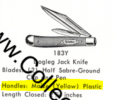- Joined
- Sep 28, 2014
- Messages
- 693
Howdy Friends,
Awhile back, my mom unearthed this old Ulster peanut that had been hers as a Girl Scout many years ago. She asked if I could clean it up for her. Can anyone tell me for sure whether or not these are celluloid handles? They look more like delrin to me, but I’ve never handled celluloid in person, so I just want to be sure. If anyone knows a model number or production date, all the better! I appreciate the help. Thanks!
TH

Awhile back, my mom unearthed this old Ulster peanut that had been hers as a Girl Scout many years ago. She asked if I could clean it up for her. Can anyone tell me for sure whether or not these are celluloid handles? They look more like delrin to me, but I’ve never handled celluloid in person, so I just want to be sure. If anyone knows a model number or production date, all the better! I appreciate the help. Thanks!
TH




